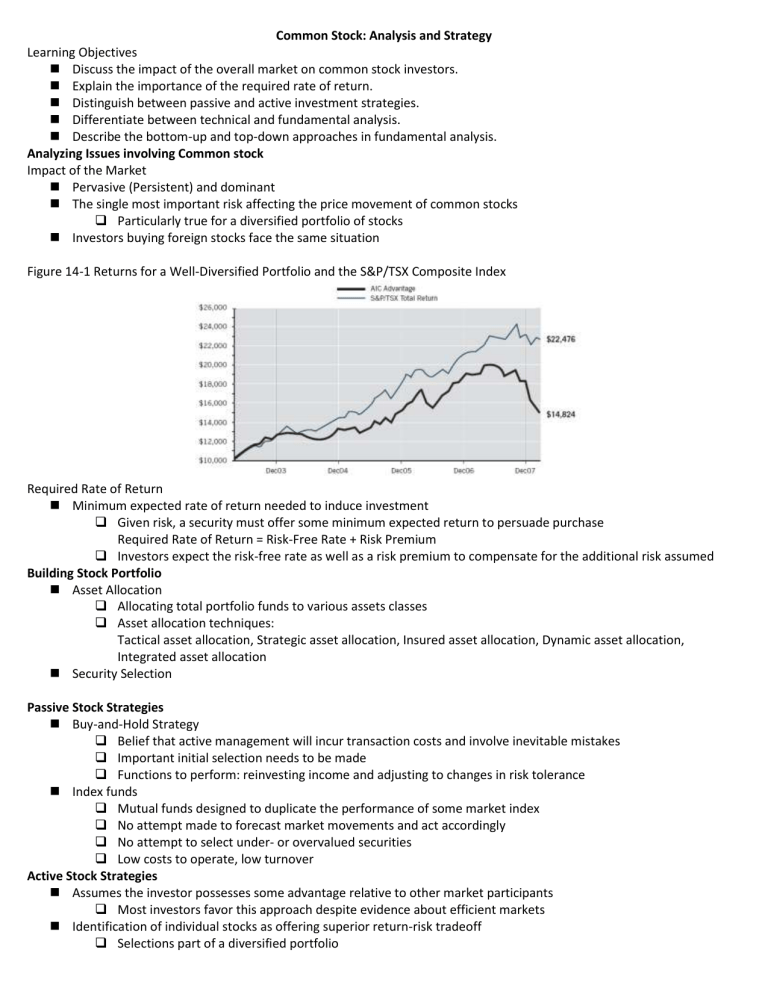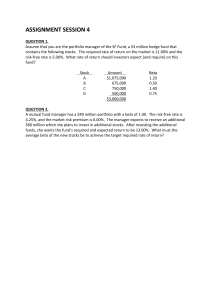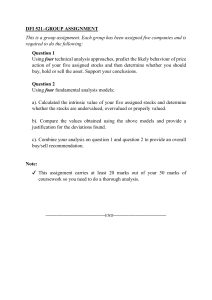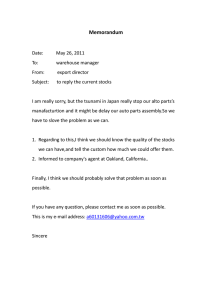
Common Stock: Analysis and Strategy Learning Objectives Discuss the impact of the overall market on common stock investors. Explain the importance of the required rate of return. Distinguish between passive and active investment strategies. Differentiate between technical and fundamental analysis. Describe the bottom-up and top-down approaches in fundamental analysis. Analyzing Issues involving Common stock Impact of the Market Pervasive (Persistent) and dominant The single most important risk affecting the price movement of common stocks Particularly true for a diversified portfolio of stocks Investors buying foreign stocks face the same situation Figure 14-1 Returns for a Well-Diversified Portfolio and the S&P/TSX Composite Index Required Rate of Return Minimum expected rate of return needed to induce investment Given risk, a security must offer some minimum expected return to persuade purchase Required Rate of Return = Risk-Free Rate + Risk Premium Investors expect the risk-free rate as well as a risk premium to compensate for the additional risk assumed Building Stock Portfolio Asset Allocation Allocating total portfolio funds to various assets classes Asset allocation techniques: Tactical asset allocation, Strategic asset allocation, Insured asset allocation, Dynamic asset allocation, Integrated asset allocation Security Selection Passive Stock Strategies Buy-and-Hold Strategy Belief that active management will incur transaction costs and involve inevitable mistakes Important initial selection needs to be made Functions to perform: reinvesting income and adjusting to changes in risk tolerance Index funds Mutual funds designed to duplicate the performance of some market index No attempt made to forecast market movements and act accordingly No attempt to select under- or overvalued securities Low costs to operate, low turnover Active Stock Strategies Assumes the investor possesses some advantage relative to other market participants Most investors favor this approach despite evidence about efficient markets Identification of individual stocks as offering superior return-risk tradeoff Selections part of a diversified portfolio Majority of investment advice geared to selection of stocks Security analyst’s job is to forecast stock returns Estimates provided by analysts Expected change in earnings per share, expected return on equity, and industry outlook Recommendations: Buy, Hold, or Sell Sector Rotation Similar to stock selection, involves shifting sector weights in the portfolio Benefit from sectors expected to perform relatively well and de-emphasize sectors expected to perform poorly Four broad sectors: Interest-sensitive stocks, consumer durable stocks, capital goods stocks, and defensive stocks Market Timing Market timers attempt to earn excess returns by varying the percentage of portfolio assets in equity securities Increase portfolio beta when the market is expected to rise Success depends on the amount of brokerage commissions and taxes paid Can investors regularly time the market to provide positive risk-adjusted returns? Approaches of Analyzing and Selecting Stock Technical analysis Refers to the method of forecasting changes in security prices Prices assumed to move in trends that persist Changes in trends result from changes in supply and demand conditions Old strategy that can be traced back to the late nineteenth century Not concerned with the underlying economic variables that affect a company or the market The causes for the demand and supply conditions are not important Technicians use graphs and charts of price changes, volume of trading over time, and other indicators Fundamental Analysis Assumes that any security (and the market as a whole) has an intrinsic value as estimated by an investor Intrinsic value compared to the current market price of the security Profits made by acting before the market consensus reflects the correct information A Framework for Fundamental Analysis Bottom-up approach Classic common stock selection strategies involve growth stocks and value stocks Growth stocks carry investor expectations of above-average future growth in earnings and above-average valuations as a result of high price/earnings ratio Value stocks feature cheap assets and strong balance sheets Top-down approach First, analyze the overall economy and conditions in security markets Second, analyze the industry within which a particular company operates Finally, analyze the company, which involves the factors affecting the valuation models Economy/Market Analysis Assess the state of the economy and the outlook for variables such as corporate profits and interest rates The status of economic activity has a major impact on overall stock prices Investors cannot go against market trends If markets move strongly, most stocks are carried along Industry Analysis An industry factor is the second component, after overall market movements, affecting the variability of stock returns The degree of response to market movements can vary significantly across industries The business cycle affects industries differently Company Analysis Security analysts typically assigned specific industries, but reports deal with individual companies Close relationship between earnings per share and share prices Dividends are closely tied to earnings, but not necessarily the current earnings Earnings are key to fundamental analysis




